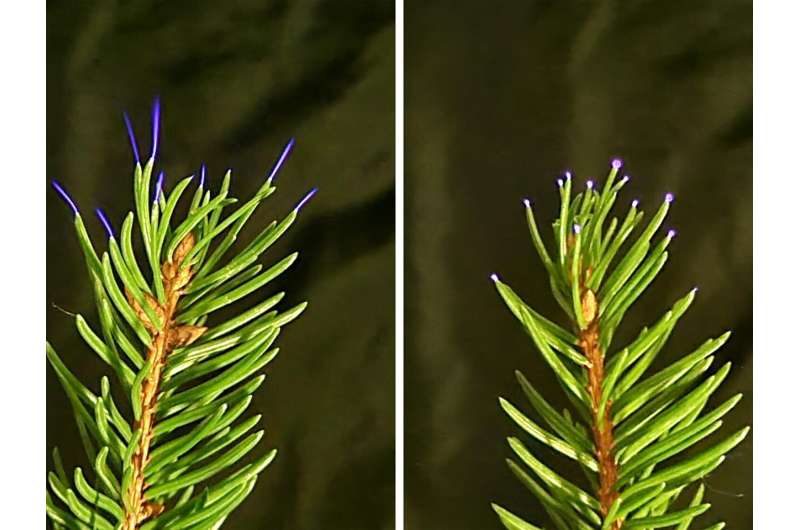Electric discharges on leaves during thunderstorms may impact nearby air quality

When thunderstorms rumble overhead, weak electrical discharges—called corona—can occur on tree leaves. A new study found coronas create large amounts of atmospheric chemicals that could impact air quality around forests, according to a team of Penn State scientists.
"While little is known about how widespread these discharges are, we estimate that coronas generated on trees under thunderstorms could have substantial impacts on the surrounding air," said Jena Jenkins, a postdoctoral scholar in the Department of Meteorology and Atmospheric Science at Penn State.
Conditions during thunderstorms that produce lightning also create electric fields between clouds and the ground. Tall, sharply pointed objects, like leaves high in trees, enhance the electric field even further, and can lead to electrical breakdowns—or coronas, the scientists said.
"There are about two trillion trees in areas where thunderstorms are most likely to occur globally and there are 1,800 thunderstorms going on at any given time," Jenkins said. "This is definitely a process that's going on all the time and based on the calculations we've been able to do so far, we think this can affect air quality in and around forests and trees."
The team found that coronas generate extreme amounts of the hydroxyl radical—OH—and the hydroperoxyl radical—HO2. The hydroxyl radical initiates important chemical reactions in the atmosphere that clean the air of greenhouse gases like methane but also produce ozone and aerosol particle pollution, the scientists said.
Corona-generated OH may increase around trees during thunderstorms by 100 to 1,000 times the typical amounts, the scientists reported in the Journal of Geophysical Research: Atmospheres.
And because OH reacts with hydrocarbons naturally emitted by leaves to produce ozone and particulate matter, these spikes in OH levels could impact air quality, the scientists said.
"The hydroxyl radical contributes to the total atmospheric oxidation of many atmospheric pollutants, including the greenhouse gas methane, improving air quality, and slowing climate change. However, these reactions can also lead to the formation of ozone and small aerosol particles, negatively affecting air quality and climate," said Willian Brune, distinguished professor of meteorology at Penn State. "So understanding all the potential sources of OH is important for predicting future air quality and climate."
The work builds on a previous study led by Brune that found lightning and subvisible discharges in storm clouds during thunderstorms represent a potentially significant source of global OH, accounting for as much as 2 to 16 % of global atmospheric OH chemistry.
"Even though the charge generated by the corona was weaker than the sparks and lightning we looked at before, we still saw extreme amounts of this hydroxy radical being made," Jenkins said.
The scientists conducted laboratory tests on leaves from eight tree species under various conditions, including wetting the leaves to simulate rain.
They found a strong correlation between OH and HO2 generated by corona discharges across the tree species and UV radiation produced by the discharges. This may be useful in conducting future research in the field, the scientists said, as equipment to measure UV radiation is more practical for field work.
Further field studies may help scientists better understand how many coronas form during thunderstorms, how long they last and how factors like wind influence the process. This work may help improve our understanding of air quality impacts on forests, the scientists said.
"The hydroxyl radical is the atmosphere's most important cleanser, so having a better accounting of where this stuff is being made can give us a more complete understanding of what's happening in the atmosphere," Jenkins said. "And thunderstorms may be happening more frequently with the changing climate. So these are good reasons to keep exploring and understanding these processes."
More information: J. M. Jenkins et al, Prodigious Amounts of Hydrogen Oxides Generated by Corona Discharges on Tree Leaves, Journal of Geophysical Research: Atmospheres (2022). DOI: 10.1029/2022JD036761
Journal information: Journal of Geophysical Research - Atmospheres
Provided by Pennsylvania State University

















